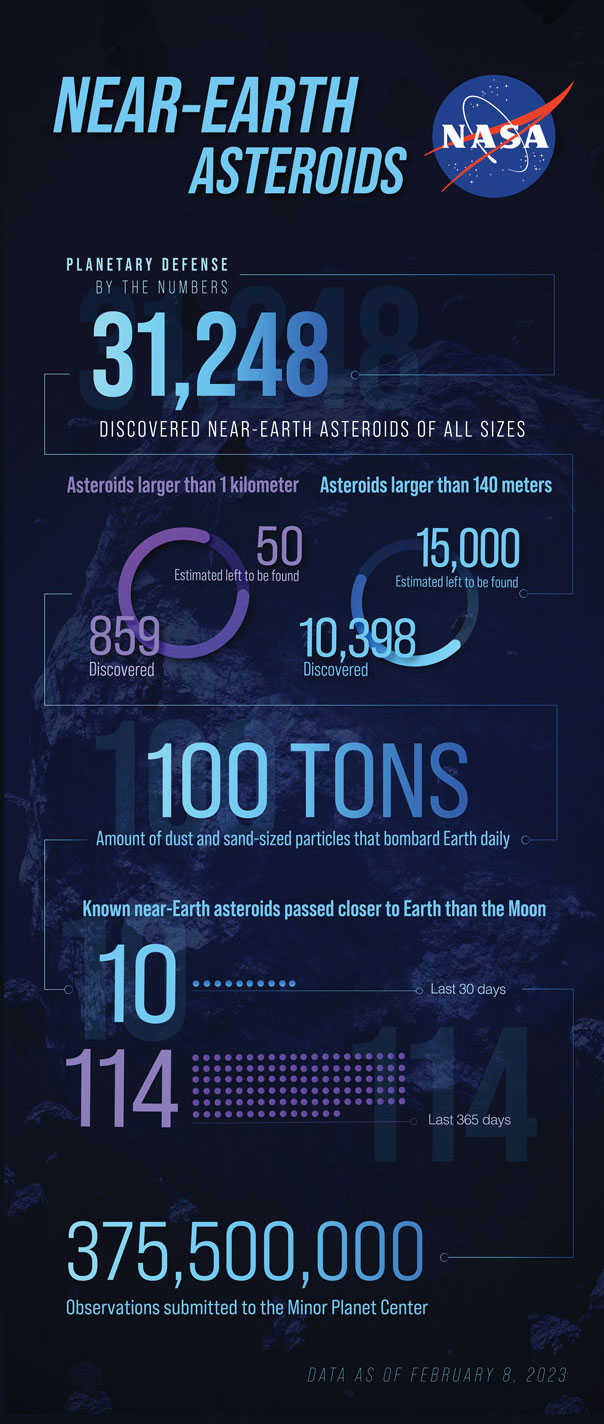
The Earth orbits within a veritable shooting gallery of asteroids. Of particular concern are near-Earth asteroids (NEAs) that pass close to our home planet, which primarily originate in the main asteroid belt between the orbits of Mars and Jupiter. While asteroids are interesting relics left over from the formation of the inner planets, nearly 200 impact craters preserved in landscapes across the world are clear evidence that many have slammed into our home planet in the past, sometimes with globally devastating effects. One of the most infamous impacts happened roughly 66 million years ago, when scientists theorize an asteroid or comet struck the Earth and led to the extinction of the dinosaurs.
Scientists have detected more than 31,000 NEAs to date out of a population thought to number in the millions. The good news is NASA has identified and tracked 95 percent of the potential civilization-enders — those more than half a mile in size — and none are an impending threat to the Earth. But smaller, more likely NEA impacts could potentially be prevented. Unlike the dinosaurs, humans have knowledge of the threat and the technology to deflect the path of a small NEA, diverting an impending impact into a harmless near miss. Only a small change in a threatening asteroid’s orbit is needed to swing it away from Earth, as long as it happens in sufficient time before the predicted impact. Southwest Research Institute engineers and scientists who study impacts and asteroids have combined forces with NASA to better understand how to accomplish that.
On September 26, 2022, at 6:14 p.m. Central time, NASA’s Double Asteroid Redirection Test (DART) spacecraft struck the asteroid moonlet Dimorphos at 13,700 mph (6.14 km/s). About 30 people attended an “Impact Watch” party at SwRI, including members of the DART Investigation Team. DART’s goal was to measure how much the moonlet’s velocity would change due to the impact. As the DART spacecraft approached the asteroid Didymos and then its moonlet Dimorphos, images of the space rocks came back nearly every second, until only a close-up portion was transmitted to Earth. When the final partial image arrived and the screen flashed red, cheers rang out. The impact had occurred.
DETAIL
Comets are small balls of ice and dirt that orbit the Sun. As a comet approaches the Sun, the heat evaporates the comet’s gases, causing it to emit dust and microparticles in a distinctive tail. Asteroids are rocky objects that also orbit the Sun. They are smaller than a planet but larger than objects known as meteoroids. A meteor is a meteoroid that burns up as it enters Earth’s atmosphere. If a meteoroid survives its trip through Earth’s atmosphere and hits the Earth’s surface, it is called a meteorite.
READY, AIM, FIRE
For decades, SwRI has studied asteroids and impacts. These two topics converged when the research community considered how to deflect an asteroid bearing down on Earth.
A spacecraft or other hypervelocity projectile aimed at the object could slam into it, changing its momentum enough to cause the minor orbital change required to avert impending disaster. Changing the momentum of an asteroid this way offers a veritable one-two punch: the direct momentum transfer of the impacting projectile pushing it forward and the asteroid’s recoil from the crater ejecta, or debris, erupting from the impact crater. The ejecta transfers momentum, propelling the target away in an “action-reaction” fashion, much like a rocket launches when high-speed gas erupts from the rear of the vehicle. Knowing just how much momentum is needed to change an NEA’s path adequately is a function of its size, composition and structure.
DETAIL
Ejecta is material forced or thrown out by an impact.
The mission was not the first time NASA intentionally slammed a spacecraft into a solar system body. In the early 2000s, SwRI supplied a flight control computer for the Deep Impact spacecraft that struck the comet Tempel 1 at 22,750 mph (10.2 km/s) on July 4, 2005. Cameras on the impacting module as well as the main spacecraft imaged the impact. The success of the Deep Impact mission led to thoughts of conducting a spacecraft-asteroid impact to measure how an impact could change the velocity and trajectory of an asteroid.
DETAIL
Planetary defense protects the Earth from impacts. Planetary protection protects other planets from contamination and germs from Earth.
When the planetary defense community considered how to make this measurement, they considered landing a transponder on the surface. Then, scientists could assess the Doppler change in the radio communication with the transponder to accurately measure the difference. Unfortunately, this approach requires a rendezvous with, and landing on, the asteroid before the impact — an expensive endeavor.
The community came up with the clever idea of selecting an asteroid with a moonlet to solve the measurement challenge. An impactor mission would aim for the moonlet and then measure its orbital period before and after the impact. Using this information, scientists could determine the speed change of the moonlet. If an asteroid flew close enough to Earth, the orbital period could be determined from Earth-based telescopes to avoid the need for a rendezvous or a flyby spacecraft. Only the impacting spacecraft would be required.
DETAIL
An orbital period is the time it takes an astronomical object to complete one orbit around another object.
Then the search for known binary asteroids — asteroids that orbit in pairs — began. An asteroid discovered in 1996 was found to have a small moon in 2003. It was named “Didymos,” which is “twin” in Greek. Didymos is in the Amor family of asteroids, which approaches Earth’s orbit as it circles the Sun. Near-Earth objects have a trajectory that brings them within 1.3 astronomical units (AU) of the Sun and within 0.3 AU, or approximately 28 million miles (45 million kilometers), of the Earth’s orbit. Specifically, Didymos is an NEA. At times, it is close enough to Earth to measure the orbital period of its moonlet Dimorphos. Another piece of information required and determined by ground-based radio (radar) telescopes is the distance between Didymos and Dimorphos. Once the target was found, mission development began in earnest.
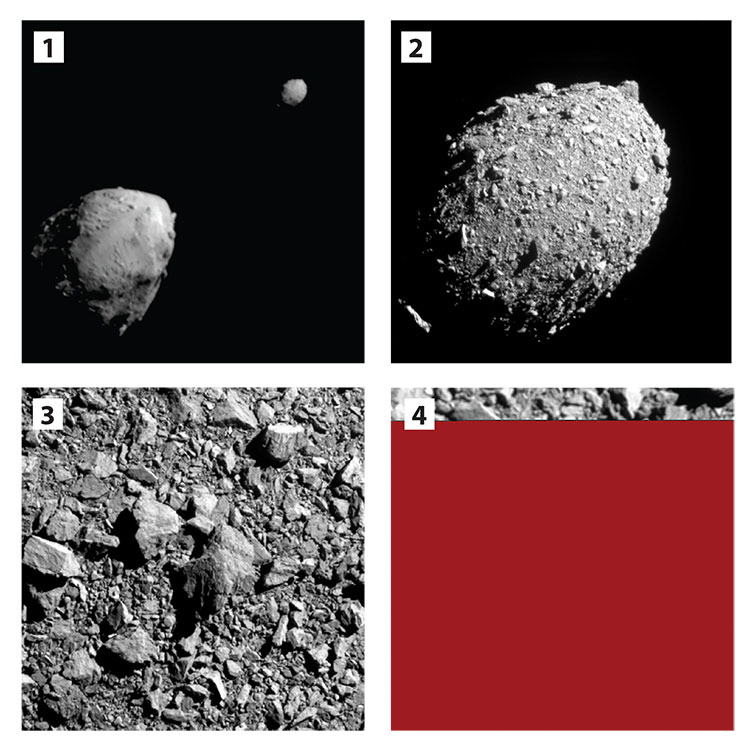
DART’s only scientific instrument, a telescope/ camera, provided these images of Dimorphos and Didymos. Image #1 is 2.5 minutes before impact from 570 miles (920 km) away and shows Didymos (bottom left) and its moonlet Dimorphos. Image #2 is the last full image of Dimorphos on approach at 11 seconds before impact from 42 miles (68 km) away. Image #3 is roughly two seconds before impact, 7 miles (11 km) away. Image #4, taken roughly 1 second before impact and 3 miles (5 km) out, is truncated because it was not fully transmitted before impact.
The DART spacecraft launched from Vandenberg Space Force Base in California on November 23, 2021. Over the next 10 months, the spacecraft never ventured far from Earth’s orbit. As the Didymos/Dimorphos system approached Earth, the impact between the DART spacecraft and Dimorphos occurred 6.8 million miles from Earth. Round-trip transmission time between Earth and the spacecraft was over a minute, so the final approach to impact was entirely autonomous.
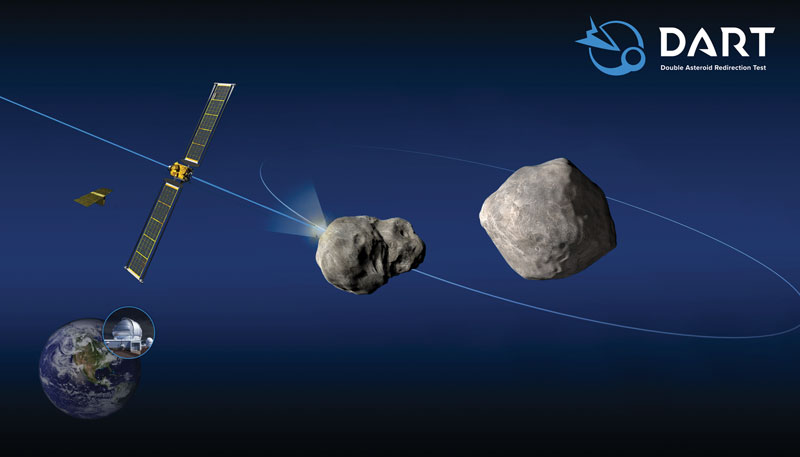
This graphic illustrates the DART spacecraft aiming for Dimorphos as it orbits Didymos.
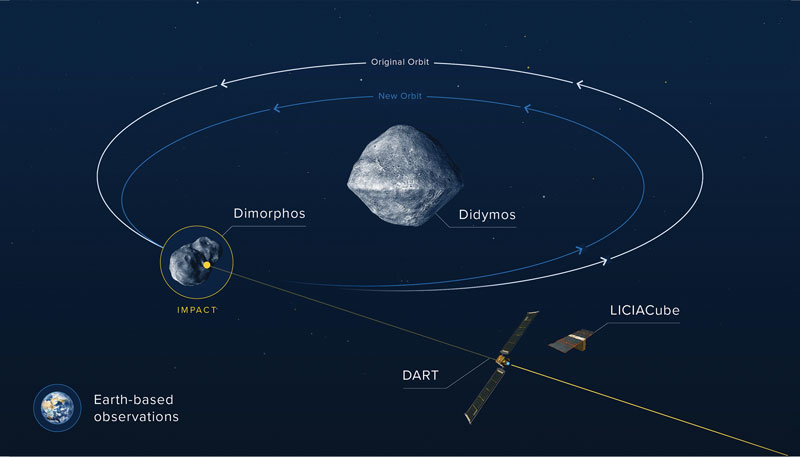
The planned impact shows how the DART impact on Dimorphos changed the orbit of the moonlet around Didymos. LICIACube is a European CubeSat that DART released three weeks before impact to take pictures as it passed.
ORBITAL FORENSICS
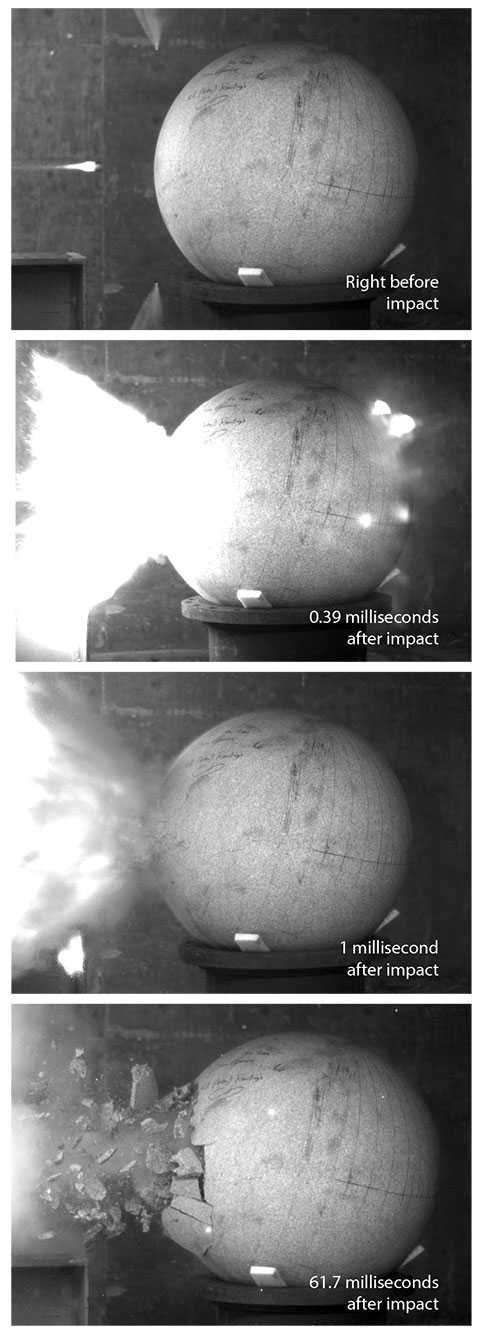
Courtesy of NASA/JHUAP
A series of images of a 1.75-inch-diameter (4.45-cm) after impact aluminum sphere impacting a 3-foot-diameter granite sphere at 4,500 mph (2.01 km/s). The first frame is right before impact showing the aluminum sphere with a vapor trail, the second at 0.39 milliseconds after impact, the third at 1 millisecond after impact and the fourth at 61.7 milliseconds after impact. Note the granite ejecta moving in the opposite direction of the incoming projectile. The ejecta increases the momentum transfer to the rest of the granite sphere.
What was the result of the impact? The original, pre-impact orbital period of Dimorphos was 11.9 hours. The impact shortened that by 33 minutes. Assuming the initial orbit was circular and the final orbit elliptical, with its farthest distance the original distance between the bodies, then the speed imparted to Dimorphos was 2.7 mm/s.
This speed increase seems minuscule. How long, in the context of deflecting an asteroid or a comet nucleus, does it take to produce large distances? Real orbits are very complicated, especially over time, but if we just use a linear extrapolation, after a day the deflection would be 750 feet (230 meters). After a month it would be 5 miles (7 km). After a year it would be over 50 miles (85 km). To deflect a distance the radius of the Earth would take 75 years.
However, Dimorphos is relatively large, around 500 feet (150 meters) in diameter, roughly the size of the Great Pyramid of Giza. To move a smaller asteroid, say one that was only 50 meters across, then its mass would be 27 times less and the time to deflect the Earth’s radius distance would be less than three years. The Chelyabinsk meteor that entered above Russia in 2013 was estimated to be 20 meters across and probably weighed around 0.2% of Dimorphos. Deflecting it out of the way with an impact would require two months of drift after an impact. However, impacts into small asteroids risk breaking them into pieces rather than deflecting them. Scientists must consider a wide range of scenarios.
The DART impact experiment explicitly determined the change in velocity. That value is specific to this spacecraft, Dimorphos and the impact arrangement. To extend the results of this impact to other scenarios, scientists need a way to use the data to estimate the deflection effect for any arrangement. For over a decade, SwRI has been studying the momentum transfer of high-speed impacts into various targets. In 2010, we crashed an aluminum sphere into a 1-yard-diameter granite sphere at 4,500 mph (2.01 km/s). The impact formed a crater, and crater materials were violently ejected in the opposite direction. This ejected material transferred more momentum to the granite sphere than the aluminum sphere brought with it. So, the impact ejecta more than doubled the momentum change. The impact physics community measures the impact ejecta momentum transferred to the body by dividing the target post-impact momentum by the incoming projectile momentum, and refers to the momentum enhancement provided by the impact ejecta ratio as β. In the experiment with the granite sphere, β=2.1. β is called momentum enhancement because, when greater than 1, it measures how much additional momentum was transferred over just the impact alone.
DETAIL
Most small asteroids are thought to be rubble-pile asteroids, which form when the parent body is smashed to pieces by an impact and the shattered debris subsequently coalesces, primarily due to self-gravitation. These asteroids are low-density and low-strength bodies due to the extensive fractures and cavities between the chunks forming them.
The momentum enhancement β is important because it can be applied in a variety of circumstances, including future impact scenarios. In the DART/Dimorphos impact, the current value of β is not well defined because the mass of Dimorphos is unknown. However, based on an assumption that the density of Dimorphos is the same as Didymos, β=3.6. The European Space Agency is planning a mission, called Hera, to rendezvous with the Didymos/Dimorphos system as early as December 2026. Hera will study the crater and other post-DART spacecraft impact features of the system and seek to pin down the mass of Dimorphos.
Recent spacecraft visits to small asteroids — including Itakawa, Ryugu and Bennu — have revealed rocky surfaces, indicative of a rubble pile or gravel conglomeration. Their rugged surfaces look very similar to Dimorphos. Before the DART experiment, SwRI performed an impact into an assembly intended to represent a rubble pile or gravel conglomeration. While the large scale of the DART/Dimorphos impact — a 1,200-pound (580 kg) spacecraft hitting a nearly 500-foot-diameter (150-meter) asteroid — cannot be replicated in the laboratory, engineers and scientists can launch an impactor at a similar speed. SwRI’s large, two-stage light-gas gun can launch projectiles to nearly 13,400 mph (>6 km/s).
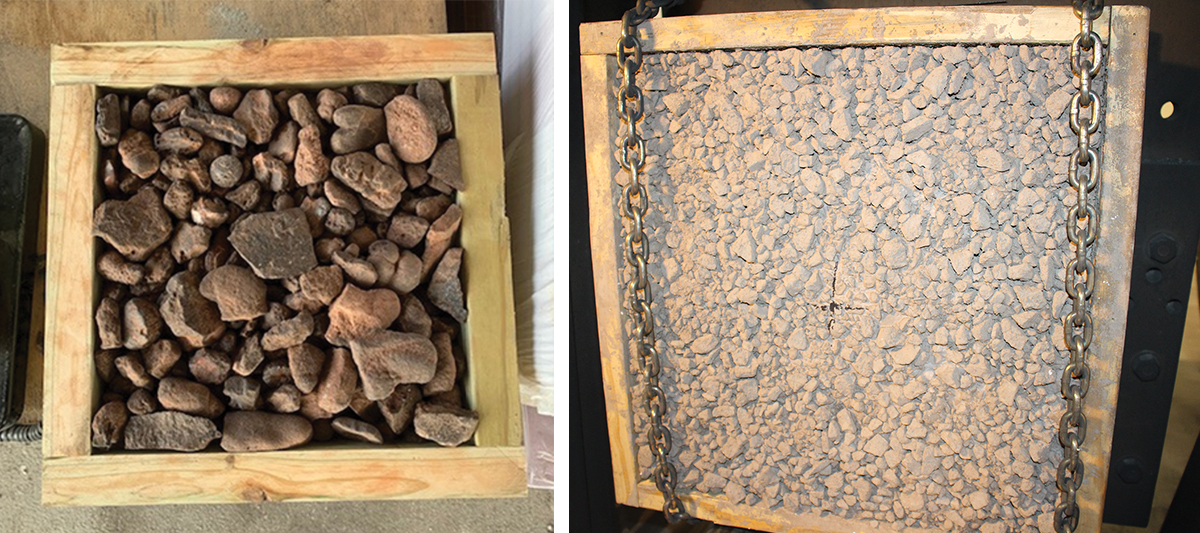
SwRI conducted a momentum enhancement experiment using rocks in a wooden frame, shown before (left) and after cement was poured (right).
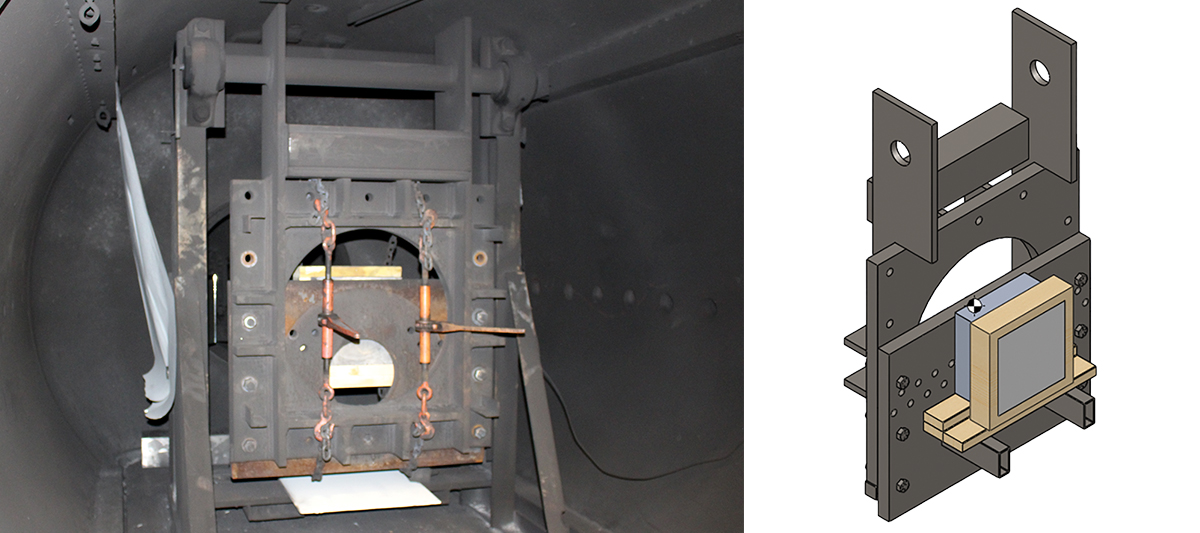
The experiment used a target hung from a pendulum in a vacuum chamber. The back side of the pendulum is shown before the impact experiment (left) and in a CAD file image of the pendulum assembly from the front (right).
TARGET PRACTICE
To understand momentum transfer, SwRI conducted small-scale experiments using a test target hung on a pendulum within a vacuum tank. The surrogate DART asteroid target was essentially a box of rocks held together with concrete, a scenario that likely exceeds the actual cohesion of the rocks on Dimorphos. While some aspects of the experiment were not representative of the moonlet, the experiment provided an experimental β for a complex geological target at the largest scale to date and at an impact speed of interest.

Impact images from SwRI’s high-speed camera show the faint glowing crescent of the incoming sphere at two frames before it strikes the cemented stone target. The glow is associated with heat generated by hypersonic flight. The next frames show the impact and three sequential images following the strike. All images are self-illuminated by light generated by flight or impact.
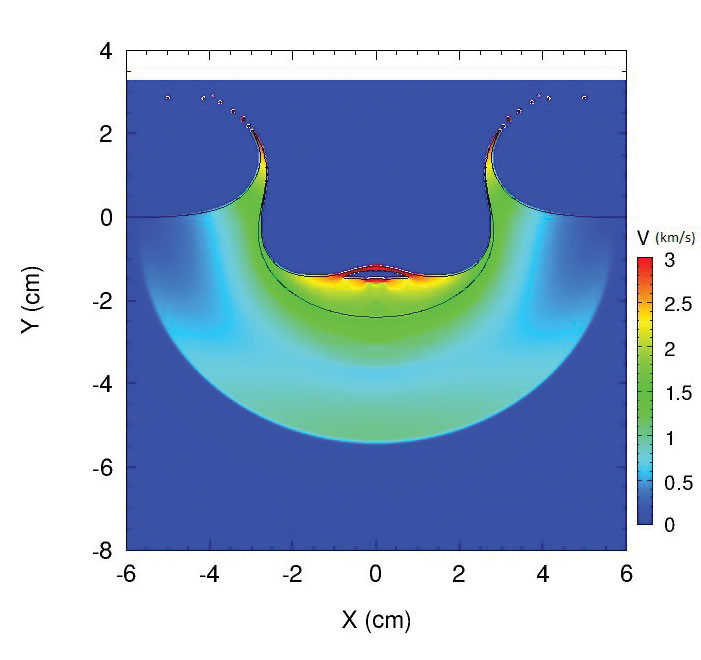
SwRI modeled the stone/ cement impact using numerical simulations to understand material speed.
The SwRI light-gas gun shot a 1.18-inch, 1.36-ounce (3-cm, 38.44-g) aluminum sphere into the rocky target at a speed of 12,150 mph (5.44 km/s), which approached the estimated speed of the DART impact. The impact completely disassembled the rock/concrete target. The debris left over ranged from a fine powder to fragments the size of the original rocks. Engineers measured the impact-based pendulum swing from the impact, determining momentum enhancement β was 3.4 times the impact imparted by the sphere alone. In other words, the ejecta leaving the crater formed by the impact more than tripled the impacting projectile’s momentum. Though aspects of the lab experiment were unlike the DART impact, a reasonable estimation of Dimorphos’ mass produces a DART value of β=3.6, similar to SwRI’s pre-impact experiment value of β=3.4.
A spherical projectile is not geometrically similar to the DART spacecraft, which had distributed mass of a roughly 6.5-foot (2-meter) cube. However, a spacecraft developed to impact and move an asteroid, such as the Deep Impact spacecraft that struck comet Tempel I, would have a consolidated impactor corresponding to a solid sphere.
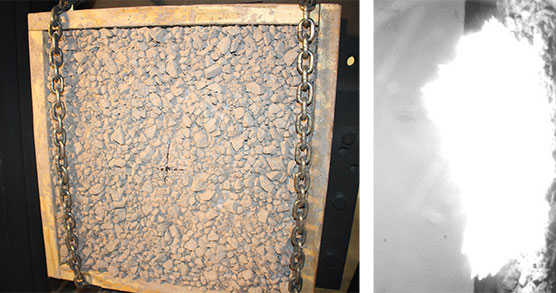
To more accurately simulate a rubble-pile asteroid, SwRI fabricated a target of crushed basalt held together with grout and sand for impact analysis. The right image shows a 12,300 mph (5.50 km/s) impact into the simulated target hung from a pendulum in a vacuum tank 20 microseconds after impact.
Well-characterized experiments also validate computation models to compute β for other impact scenarios. SwRI has used computations for more than a decade to explore various aspects of spacecraft impacts on asteroids and comet nuclei. Engineers and scientists have studied how spacecraft shape, as well as asteroid and comet nuclei composition, density, strength and cohesion (tensile fracture strength) affect β, some more than others. In addition to studying these material properties, experiments indicate that overall size affects the results and size scaling is nonlinear. As the overall size of the event increases, so does the nondimensional momentum enhancement β. The SwRI team is presently performing additional experiments and computations to further understand momentum enhancement. New targets include different distributions of rock sizes and holding them in place with grout and sand to reduce the cohesive strength. SwRI is working to obtain reliable β values to validate computational models and quantitatively analyze future impact scenarios, in case they are needed sometime in the future to make sure humans don’t go the way of the dinosaurs.
Questions about this story or Blast & Impact? Contact James Walker at +1 210 522 2051.
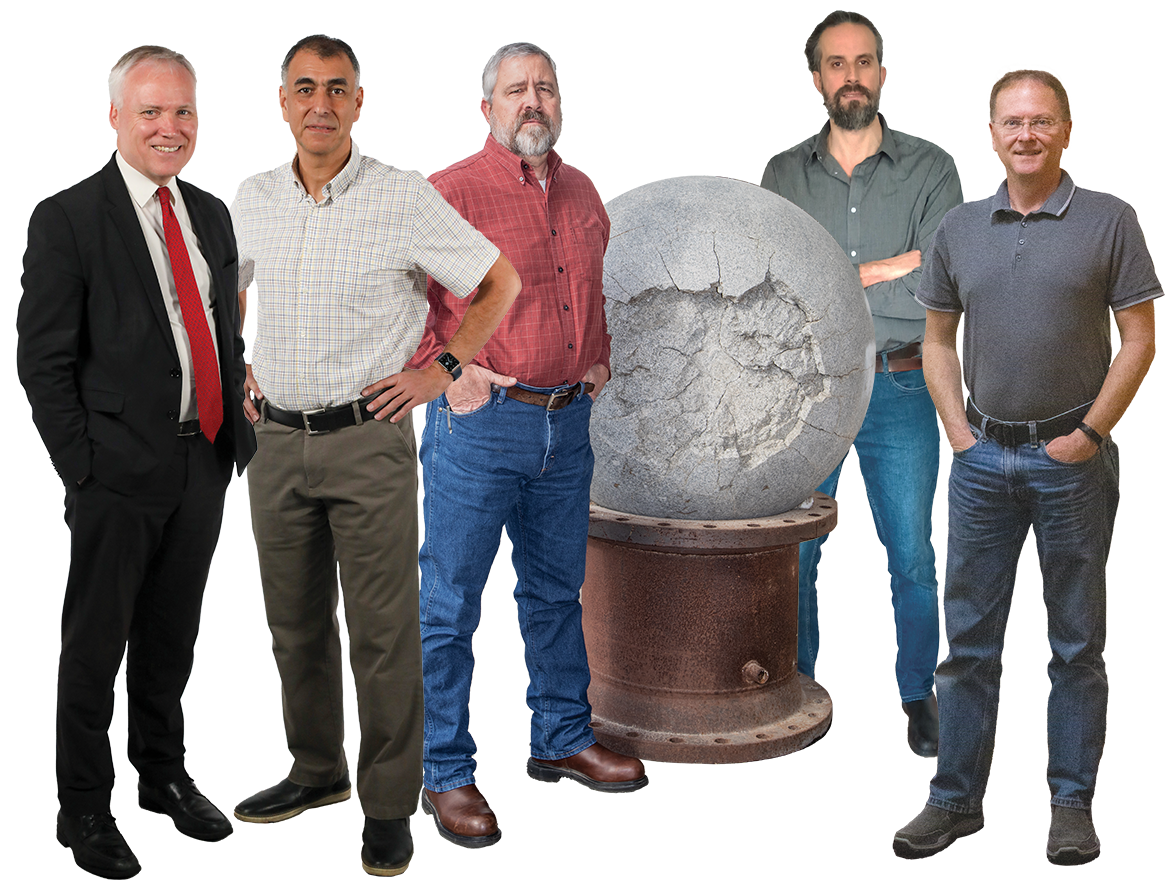
About the Authors
The article authors are shown around a three-foot-diameter granite asteroid surrogate after an impact by a nearly two-inch aluminum sphere to characterize momentum enhancement provided by materials ejected from the crater. From left, Dr. James Walker directs SwRI’s Engineering Dynamics Department, which researches impacts, including the damage, fracture and failure of metals, composites, ceramics and small-scale surrogate asteroids. Dr. Sidney Chochron manages the Computational Mechanics Section and has extensive experience in using numerical modeling to understand impacts. Don Grosch manages SwRI’s Ballistics and Explosives Engineering Section, operating onsite and offsite ballistics ranges as well as a two-stage light-gas gun capable of creating small-scale hypervelocity impacts. Dr. Simone Marchi, a staff scientist in SwRI’s Solar System Science and Exploration Division in Boulder, specializes in the collisional evolution of asteroids and terrestrial planets. Dr. Dan Durda, also in the Boulder office, is a principal scientist who studies the collisional and dynamical evolution of main belt and near-Earth asteroids, Vulcanoids, Kuiper belt comets and interplanetary dust.
Acknowledgments: The authors thank contractor/engineer Nikki Scott and student intern Mackenzie Darilek for assistance with target fabrication and Robert Enriquez-Vargas, Joe Elizondo, Scott Barclay and Chris McGarry for experimental support. This work was funded through the Institute’s Internal Research and Development program; the authors thank SwRI for supporting this research. Early impact studies were supported by NASA’s Outer Planets Research program, grant number NNG06GE91G. Continuing DART-related momentum enhancement experiments were supported by NASA’s Yearly Opportunities for Research in Planetary Defense program, grant number 80NSSC22K0241. Seven SwRI staff were members of the DART Investigation Team. The mission was managed by Johns Hopkins Applied Physics Lab for NASA’s Planetary Defense Coordination Office.

